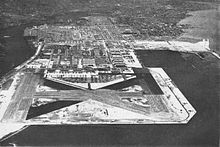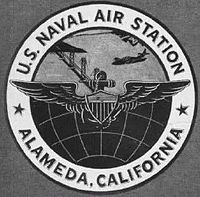- Naval Air Station Alameda
-
Naval Air Station Alameda 
Aerial view of NAS Alameda in the mid-1940s IATA: NGZ – ICAO: KNGZ Summary Airport type Military: Naval Air Station Operator United States Navy Location Alameda, California In use 1940[1] - 1997 Coordinates 37°47′10″N 122°19′07″W / 37.78611°N 122.31861°WCoordinates: 37°47′10″N 122°19′07″W / 37.78611°N 122.31861°W Runways Direction Length Surface ft m 07/25 8,000 2,438 Asphalt 13/31 7,200 2,195 Asphalt Naval Air Station Alameda (NAS Alameda) was a United States Navy Naval Air Station in Alameda, California, on San Francisco Bay.[2]
NAS Alameda had two runways: 07-25 (8,000×200 ft) (2,438×61 m) and 13-31 (7,200×200 ft) (2,195×61 m). Two helicopter pads and a control tower were also part of the facilities.
Contents
History
In 1927, wetlands at the west end of Alameda Island on the east shore of San Francisco Bay were filled to form an airport with an east/west runway, three hangars, an administration building, and a yacht harbor. The airport site included the Alameda Terminal of the First Transcontinental Railroad (California Historical Landmark #440). By 1930, United States Army Air Corps operations referred to the site as Benton Field. Pan American World Airways used the yacht harbor as the California terminal for China Clipper trans-Pacific flights beginning in 1935. The China Clipper terminal is designated California Historical Landmark #968. On 1 June 1936, the city of Alameda, California ceded the airport to the United States government a few months before the Army discontinued operations from the field. Pan American World Airways shifted its terminal to Treasure Island in 1939 for the Golden Gate International Exposition. Congressional appropriations passed in 1938 for construction of naval air station facilities for two carrier air wings, five seaplane squadrons and two utility squadrons. Appropriations were increased in 1940 for construction of two seaplane hangars and an aircraft carrier berthing pier, and naval operations began on 1 November 1940. Fleet Air Wing 8 began patrol and scouting missions following the attack on Pearl Harbor. In April 1942, the USS Hornet (CV-8) loaded at Alameda the 16 B-25 aircraft that would take part in the Doolittle Raid on Japan.[1]
As World War II continued, Alameda became headquarters for a system of auxiliary airfields:[1]
- Arcata Auxilliary Airfield
- Clear Lake Outlying Field
- Concord Outlying Field
- Crescent City Outlying Field
- Crows Landing Naval Auxiliary Air Station
- Fallon Auxiliary Airfield
- Half Moon Bay Outlying Field
- Hollister Auxiliary Airfield
- King City Auxiliary Airfield
- Livermore Auxiliary Airfield
- Monterey Auxiliary Airfield
- Oakland Auxiliary Airfield
- Paso Robles Outlying Field
- San Francisco Auxiliary Airfield
- San Luis Obispo Outlying Field
- Santa Rosa Outlying Field
- Treasure Island Auxiliary Airfield
- Tulare Lake Outlying Field
- Vernalis Auxiliary Airfield
- Watsonville Auxiliary Airfield
Alameda remained an important naval base through the Cold War. From 1949 to 1953, the Navy based the Lockheed Constitution—the largest airplane ever listed on the Navy inventory—at NAS Alameda. The two prototypes regularly flew between nearby NAS Moffett Field and Pearl Harbor, Hawaii. The base was the focus for northern California United States Navy Reserve drill after 1961. Runways were lengthened for jet aircraft, and the airport was renamed Nimitz Field in 1967 following the death of Admiral Chester W. Nimitz. Nuclear powered aircraft carriers were home ported at Alameda into the 1990s, and thousands of local civilians were employed overhauling aircraft at the naval aviation depot.[1]
Post-closure uses
After the base closed on 25 April 1997, the USS Hornet (CV-12) was given to the former air station to be used as a museum ship, the USS Hornet Museum.
The television series MythBusters often conducts its more destructive experiments on the grounds of the station, due to the extensive safety zone which it provides. For the same reason, this location has been used as a checkpoint for the Bullrun rally race—the lengthy airstrip allowed for the staging of a challenge involving chasing a semi-trailer.
A two-mile freeway loop was constructed on the base for the filming of a lengthy car chase sequence for the movie The Matrix Reloaded. The loop cost over $1.5 million to construct and was used solely for shooting the film's chase scenes (a seven-week long process) before it was demolished.[3]. The route is still visible on aerial photography on the former 07/25 and 13/31 runways. As of November 2011 an aerial view on Google Maps shows one of the runways being used for a simulated airliner crash for an unidentified film or TV production.[4]
The City of Alameda has been planning the redevelopment of the former Naval Air Station, now known as Alameda Point, since 2000. Complicating the redevelopment are several constraints: land-use constraints consisting of Tidelands Trust; soil and groundwater contamination; wildlife refuge buffer requirements; geotechnical issues; 100-year flood plans; institutional and contractual constraints with Alameda Measure A, the Alameda Naval Air Station Historic District and existing residents and leases.
In August 2001, Alameda selected Alameda Point Community Partners (APCP) as the master developer for the property. APCP was a partnership of financier Morgan Stanley, Shea Homes of Livermore, Centex Homes of Dallas and the Industrial Realty Group. The development was estimated to cost $2 billion and take 15 years to complete. Alameda Point Community Partners was selected over Catellus and Harbor Bay/Lennar, and signed a two-year exclusive negotiating contract as the property’s master developer.
By 2005, only Shea Homes and Centex Homes were working on redevelopment plans, and a Preliminary Development Concept called for building 1,700 homes on the site. In July 2006, the City of Alameda and the Navy agreed to a $108 million purchase deal. In September 2006, APCP decided that it would not move forward with the development plan identified in the Preliminary Development Concept and withdrew from the project.
In May 2007, the City selected SunCal Companies as the master developer from a field of five applicant firms that sought to develop 770 acres. In July 2007, the City and SunCal entered into an exclusive negotiating agreement as SunCal began to gather community input and develop preliminary plans.
In August 2010, the Alameda City Council voted to terminate the exclusive negotiating agreement with SunCal and halt its proposal for the former Naval Air Station. Various reasons were cited in the staff report leading up to the vote, including the developer- and city-initiated ballot measure related to the project that was defeated in February 2010 by a margin of 85%.
Superfund cleanup site
NAS Alameda was listed as a Superfund cleanup site on July 22, 1999. 25 locations on the base were identified as needing remediation. The largest of the individual locations is the West Beach Landfill which occupies approximately 110 acres (44.5 ha) in the southwestern corner of the base. Tests of the landfill indicate polychlorinated biphenyl (PCB) contamination.[5]
See also
- List of airports in the San Francisco Bay Area
- San Francisco Naval Shipyard
- Base Realignment and Closure
Notes
- ^ a b c d "California State Military Museum". M.L.Shettle. http://www.militarymuseum.org/NASAlameda.html. Retrieved 2011-08-02.
- ^ "Alameda Naval Air Station (historical)". Geographic Names Information System, U.S. Geological Survey. http://geonames.usgs.gov/pls/gnispublic/f?p=gnispq:3:::NO::P3_FID:1680357. Retrieved 3 May 2009.
- ^ Gordon, Devin (December 30, 2002). "The Matrix Makers". Newsweek. http://www.newsweek.com/id/67002. Retrieved 1 March 2008.
- ^ Google Maps view, accessed Nov. 6, 2011
- ^ "NPL Site Narrative for Alameda Naval Air Station". National Priorities List. United States Environmental Protection Agency. 24 February 2006. http://www.epa.gov/superfund/sites/npl/nar1560.htm. Retrieved 10 August 2007.
References
- Alameda Naval Air Museum
- Historic Posts: Naval Air Station, Alameda
- Globalsecurity.org's history of Alameda Point
External links
- Abandoned & Little-Known Airfields: NAS Alameda
- Aerial photos from Google Local
- Aerial photo from USGS via Microsoft Research Maps
Operational military installations of CaliforniaArmy  FortAirfieldHeliportRange
FortAirfieldHeliportRange
Marines  Air StationCampRangeLogistics
Air StationCampRangeLogisticsNavy  DepotAlameda Point • Long Beach • Port HuenemeOutlying FieldPortStationRangeSchool
DepotAlameda Point • Long Beach • Port HuenemeOutlying FieldPortStationRangeSchoolAir Force  Range
RangeNational Guard  School
SchoolCoast Guard  Station
StationAirports in the San Francisco Bay Area International Federal General aviation (tower) Concord/Buchanan (KCCR) · Hayward (KHWD) · Livermore (KLVK) · Napa (KAPC) · Palo Alto (KPAO) · San Jose/Reid-Hillview (KRHV) · San Carlos (KSQL) · Santa Rosa/Sonoma County (KSTS)General aviation (non-tower) Angwin-Parrett (2O3) · Byron (C83) · Cloverdale (O60) · Marin County/Gnoss (KDVO) · Half Moon Bay (KHAF) · Healdsburg (O31) · Hollister (KCVH) · Vacaville/Nut Tree (KVCB) · Petaluma (O69) · Rio Vista (O88) · Sonoma Skypark (0Q9) · Sonoma Valley (0Q3) · San Martin/South County (E16) · Watsonville (KWVI)Historical Categories:- Airports in the San Francisco Bay Area
- Alameda, California
- Environment of California
- History of the San Francisco Bay Area
- Places in the San Francisco Bay Area
- Defunct airports in California
- Military Superfund sites
- United States naval air stations
- United States Navy bases
- Closed facilities of the United States Navy
- History of Alameda County, California
- Buildings and structures in Alameda County, California
Wikimedia Foundation. 2010.


